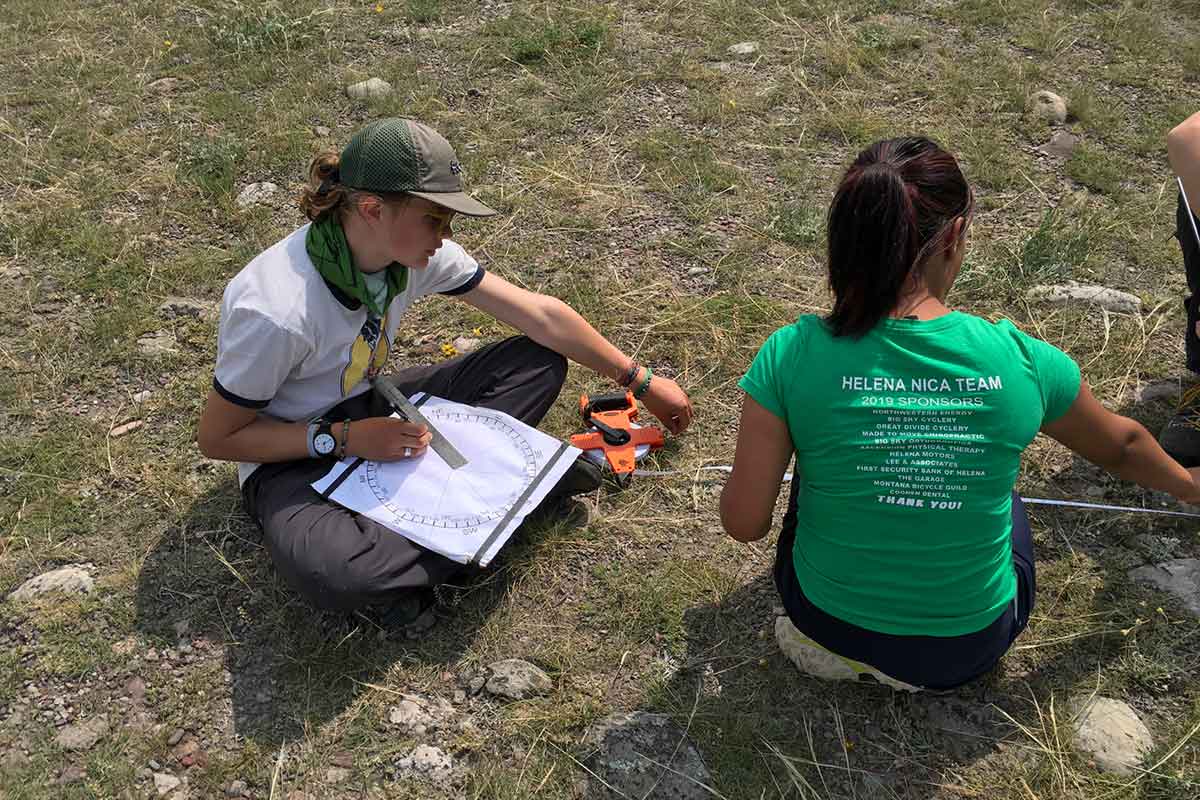By Eve Byron
Augusta, Montana—Warblers and sparrows lift the spirits here while the deer flies dive bomb a small group of students focused on their task—recording the placement of historic stone circles, likely tipi rings, near the banks of the Sun River along the Rocky Mountain Front.
It’s a new endeavor for the Youth Forest Monitoring Program, a project by the Helena-Lewis and Clark National Forest in partnership with the Montana Discovery Foundation. For 24 years, they’ve brought student scientists into the field each summer to monitor weeds, streams, and soils on public lands.
This year, with the help and funding from the Montana Historical Society, its State Historical Preservation Office, (SHPO), and the state Department of Natural Resources and Conservation, they’re adding archeology to the mix with the Youth Archaeological Survey Program.
“The program’s origins are part of our effort to expand surveys and engage the next generation of would-be archaeologists,” said Pete Brown, who leads the SHPO program. “Melissa Munsen with SHPO helped found the YFMP program 25 years ago, so we’re contracting with the Forest Service to recruit students, coordinate, and lead the day-to-day archeological operations.”
Along with recording the tipi rings near the Sun River, the students were slated to examine the implications of mine cleanup at the historic Charter Oak Mine and backpack into an old administrative Forest Service cabin near Heart Lake in the Scapegoat Wilderness Area to assess the condition of the cabin after years of use since the original recording.
“It’s good for them to see different sites and how we do Cultural Resource Management, or CRM, at the various sites,” said Laura Marsh, an archeologist with the MTHS. “Basically, they’re learning how we manage historical and archeological sites, especially in the context of national and state laws.”
For some of the YFMP participants, the hands-on archeology component fits right within their interests. Libby Zorn, 23, is the field instructor for the archeology team and a senior at the Montana State University in Bozeman, graduating in December with a major in history and a minor in anthropology.
“The Indigenous part is new to me because my interest is in the Viking age,” Zorn said. “Getting to know what’s here in our own backyard is really interesting.”
For a different reason, that opportunity spoke to Copen Earley, 15, from East Helena.
“I wanted to learn more about environmental science,” Earley said. “I want to go into civil engineering and that’s a big part – knowing how to design things so they last.”
On this day, Patrick Rennie, an archeologist with DNRC, oversees showing the six students how professionals document the stone circles on state lands. The site was initially thought to have about four or five tipi rings. A recent closer inspection showed the area is home to over 60 rings.
Initially, they’re difficult to ascertain among the thousands of stones left behind when the glaciers receded about 19,000 years ago, and today long grasses help hide them. But Marsh and Rennie have an eye for spotting them, and they slowly come into focus. Once they show the students a few rings, it’s easy to see them almost everywhere in this historically—or even prehistorically—popular campsite.
“I spent some time out here over the last year, wanting to update the site, and it went from four or five features to 61,” Rennie said. “They may have been from maybe five or six families who one-time occupied this landscape over 50 or 60 years ago—or it can be a few thousand years and maybe 200 families. We simply don’t know.”
The rocks were placed around the bottom—or skirt—of a tipi to hold the walls in place and were left behind when the Native Americans using the site moved. Rennie has a theory that the rocks left in the middle of the circles may not only be hearths. Instead, they might have been suspended in a bag made from hides to help stabilize the tipis on windy days.
Rennie easily interacts with the students, pulling tools from a bright yellow bag and giving them a hands-on opportunity to do the work of a trained archeologist in the hopes that it might whet their appetite for this field of work.
“It seems like most archeological courses in high school and college are done in academic settings, and not outside where the work exists,” Rennie said. “I want to encourage them by giving interested people some first-hand experience of what archeology is like.
“The goal is to develop an interest in younger folks—or all ages, really,” Rennie said. “Hopefully, they develop an appreciation of what’s out there on the landscape, even if it’s not their chosen career.”
Sweetening the pot today is a mix of high- and low-technology. After lunch, the students sprinkle flour on some of the rock rings, and a flying drone snaps photos to better see the layout of the stones.
“Then we overlay it and see how accurate we are with the maps,” Rennie said. “This will be part of the presentation.”
All the YFMP students will share their findings at the end of their field season on July 27 at the Helena College auditorium during a meeting with the Forest Service and other interested parties. MSN









